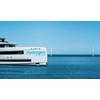The newly repowered M/V Herbert C. Jackson departed Fraser Shipyards in Superior, Wis., yesterday giving a farewell salute to the Twin Ports where it has been undergoing its steam-to-diesel conversion since December 21.
As the last steam-powered ship in Interlake Steamship Company’s fleet, the conversion of the Herbert C. Jackson represents the final phase of the company’s decade-long modernization program to create the most efficient, reliable and environmentally responsible fleet on the Great Lakes.
The 690-foot Jackson is the fifth ship to undergo a major overhaul and Interlake’s fourth and last steam-to-diesel conversion since 2006.
“After a successful repowering at Fraser Shipyards, the Herbert C. Jackson returns to service as an extremely versatile and efficient River Class freighter with a bright new future of carrying cargoes for our Great Lakes customers for decades to come,” said Interlake President Mark W. Barker.
Regularly carrying upwards of 25,000 tons of iron ore between Marquette and Detroit, Mich., the Jackson was powered by an aging steam turbine and two boilers, which have operated since the ship was built in 1959. Maintenance burdens and new emission requirements fueled Interlake’s decision to repower the ship.
“Even though steamships will always be an important part of our company’s legacy and the history of shipping on the Lakes, we are very excited to enter an era where our modernized fleet can exceed the expectations of our customers while minimizing our environmental impact,” Barker said.
The Jackson’s new highly automated engine room includes a 6,250-BHP propulsion package with a pair of MaK 6M 32E engines – the first of their kind to power a vessel on the Great Lakes. These engines give the ship enhanced propulsion capabilities and reliability.
In addition, the ship has been outfitted with a twin-input, single-output Lufkin gear box with twin pto shaft generators, a Schottel controllable-pitch propeller system and Gesab exhaust gas economizers along with an auxiliary boiler. The economizers allow the ship to harness the waste heat and energy from the main engine exhaust and produce “free steam” to heat the accommodations and for heating various auxiliary systems and fuel oil services.
The repowering is estimated to reduce the ship’s emissions of particulate matter by 35 percent, carbon dioxide by 57 percent and sulfur oxides (SOx) by 63 percent.













